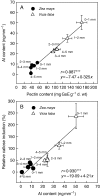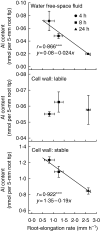The role of the root apoplast in aluminium-induced inhibition of root elongation and in aluminium resistance of plants: a review
- PMID: 20237112
- PMCID: PMC2889789
- DOI: 10.1093/aob/mcq053
The role of the root apoplast in aluminium-induced inhibition of root elongation and in aluminium resistance of plants: a review
Abstract
Background: Aluminium (Al) toxicity is the most important soil constraint for plant growth and development in acid soils. The mechanism of Al-induced inhibition of root elongation is still not well understood, and it is a matter of debate whether the primary lesions of Al toxicity are apoplastic or symplastic.
Scope: The present review focuses on the role of the apoplast in Al toxicity and resistance, summarizing evidence from our own experimental work and other evidence published since 1995.
Conclusions: The binding of Al in the cell wall particularly to the pectic matrix and to the apoplastic face of the plasma membrane in the most Al-sensitive root zone of the root apex thus impairing apoplastic and symplastic cell functions is a major factor leading to Al-induced inhibition of root elongation. Although symplastic lesions of Al toxicity cannot be excluded, the protection of the root apoplast appears to be a prerequisite for Al resistance in both Al-tolerant and Al-accumulating plant species. In many plant species the release of organic acid anions complexing Al, thus protecting the root apoplast from Al binding, is a most important Al resistance mechanism. However, there is increasing physiological, biochemical and, most recently also, molecular evidence showing that the modification of the binding properties of the root apoplast contributes to Al resistance. A further in-depth characterization of the Al-induced apoplastic reaction in the most Al-sensitive zone of the root apex is urgently required, particularly to understand the Al resistance of the most Al-resistant plant species.
Figures






Similar articles
-
From stress to responses: aluminium-induced signalling in the root apex.J Exp Bot. 2023 Mar 13;74(5):1358-1371. doi: 10.1093/jxb/erac516. J Exp Bot. 2023. PMID: 36609593
-
Apoplastic binding of aluminum is involved in silicon-induced amelioration of aluminum toxicity in maize.Plant Physiol. 2004 Nov;136(3):3762-70. doi: 10.1104/pp.104.045005. Epub 2004 Oct 22. Plant Physiol. 2004. PMID: 15502015 Free PMC article.
-
The role of root exudates in aluminium resistance and silicon-induced amelioration of aluminium toxicity in three varieties of maize (Zea mays L.).J Exp Bot. 2001 Jun;52(359):1339-52. J Exp Bot. 2001. PMID: 11432953
-
Kinetics and nature of aluminium rhizotoxic effects: a review.J Exp Bot. 2016 Aug;67(15):4451-67. doi: 10.1093/jxb/erw233. Epub 2016 Jun 14. J Exp Bot. 2016. PMID: 27302129 Review.
-
Aluminum stress signaling in plants.Plant Signal Behav. 2009 Jul;4(7):592-7. doi: 10.4161/psb.4.7.8903. Epub 2009 Jul 28. Plant Signal Behav. 2009. PMID: 19820334 Free PMC article. Review.
Cited by
-
Hyper, a hydrogen peroxide sensor, indicates the sensitivity of the Arabidopsis root elongation zone to aluminum treatment.Sensors (Basel). 2015 Jan 6;15(1):855-67. doi: 10.3390/s150100855. Sensors (Basel). 2015. PMID: 25569758 Free PMC article.
-
Appraisal of Abelmoschus esculentus L. Response to Aluminum and Barium Stress.Plants (Basel). 2023 Jan 1;12(1):179. doi: 10.3390/plants12010179. Plants (Basel). 2023. PMID: 36616306 Free PMC article.
-
Aluminum-Induced Alterations to the Cell Wall and Antioxidant Enzymes Involved in the Regulation of the Aluminum Tolerance of Chinese Fir (Cunninghamia lanceolata).Front Plant Sci. 2022 Apr 28;13:891117. doi: 10.3389/fpls.2022.891117. eCollection 2022. Front Plant Sci. 2022. PMID: 35574080 Free PMC article.
-
Cultivar Differences in the Biochemical and Physiological Responses of Common Beans to Aluminum Stress.Plants (Basel). 2021 Oct 3;10(10):2097. doi: 10.3390/plants10102097. Plants (Basel). 2021. PMID: 34685906 Free PMC article.
-
Natural variation underlies alterations in Nramp aluminum transporter (NRAT1) expression and function that play a key role in rice aluminum tolerance.Proc Natl Acad Sci U S A. 2014 Apr 29;111(17):6503-8. doi: 10.1073/pnas.1318975111. Epub 2014 Apr 11. Proc Natl Acad Sci U S A. 2014. PMID: 24728832 Free PMC article.
References
-
- Ahn SJ, Rengel Z, Matsumoto H. Aluminum-induced plasma membrane surface potential and H+-ATPase activity in near-isogenic wheat lines differing in tolerance to aluminum. New Phytologist. 2004;162:71–79.
-
- Akeson MA, Munns DN, Burau RG. Adsorption of Al3+ to phosphatidylcholine vesicles. Biochimica et Biophysica Acta. 1989;986:33–40. - PubMed
-
- Amenós M, Corrales I, Poschenrieder C, Illés P, Baluska F, Barceló J. Different effects of aluminum on the actin cytoskeleton and brefeldin A-sensitive vesicle recycling in root apex cells of two maize varieties differing in root elongation rate and aluminum tolerance. Plant and Cell Physiology. 2009;50:528–540. - PubMed
-
- Basu U, Good AG, Aung T, et al. A 23-kDa, root exudate polypeptide co-segregates with aluminum resistance in Triticum aestivum. Physionogia Plantarum. 1999;106:53–61.
Publication types
MeSH terms
Substances
LinkOut - more resources
Full Text Sources
Miscellaneous

